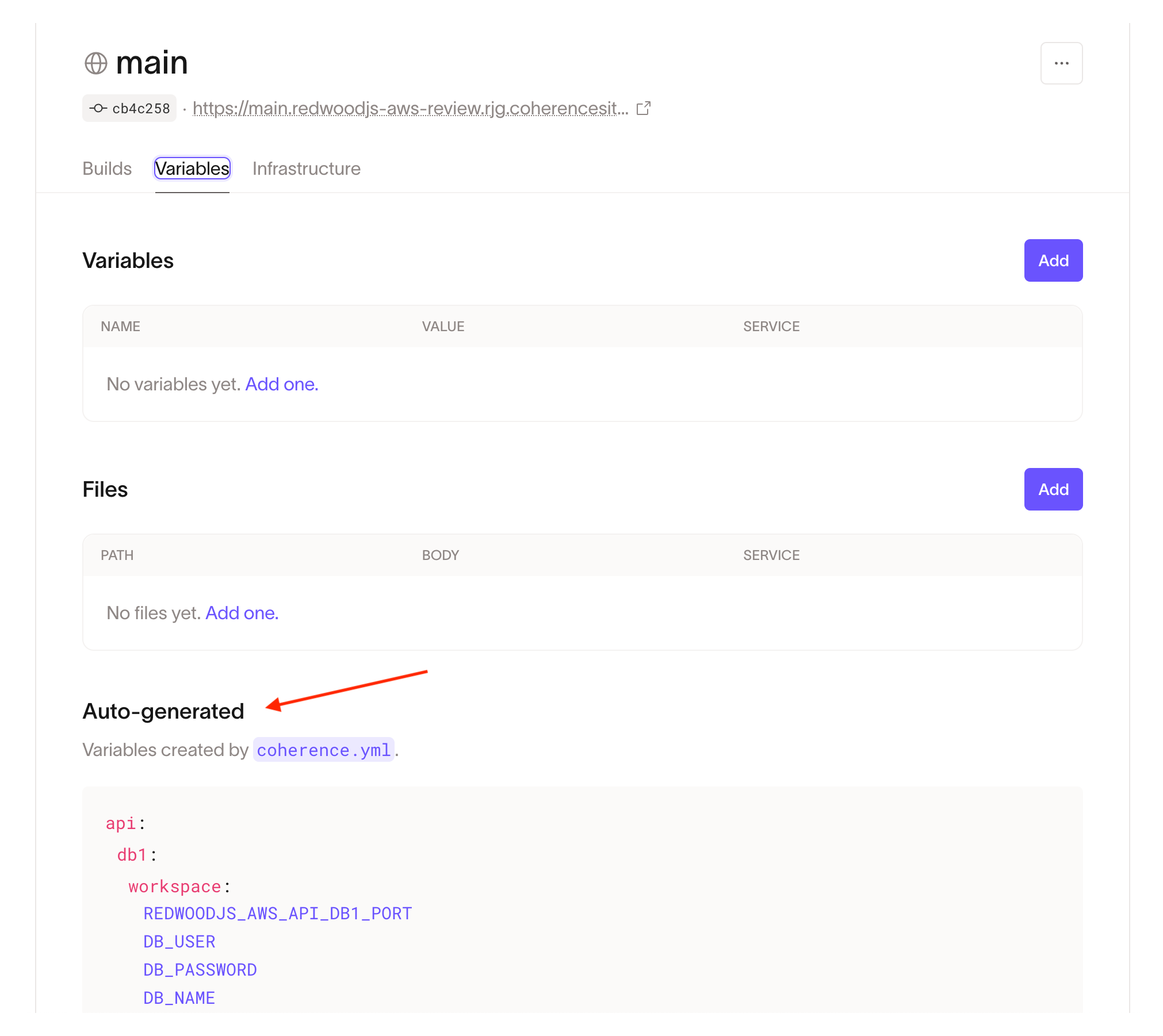Reference
Environment Variables
User Managed Variables
Coherence provides a UI for managing environment variables that will be configured for your application. These variables are stored in cloud secrets manager in your cloud (Coherence does not store a copy of them) and cloud integrations into build pipelines and container runtimes are used in order to make them available to your code in the most secure manner possible. This gives you a developer-friendly way to use your cloud secrets manager in all the different contexts you need to, in a developer-friendly way.
Secrets vs. Variables
We do not distinguish between secure secrets and insecure variables. All the variables you add to Coherence will be treated as secrets.
Environment Inheritance
There are 2 places that you can configure variables in the Coherence UI:
- The "Variables" tab in Preview/Production: these variables will be inherited by all environments in that cloud project (for example the variables in the "Peview" project will be available in all Branch Previews by default)
- The environment's "Variables" tab: these will only apply to the environment they are configured on. You can also override inherited variables
Nested Variables
We currently do not support reference of one variables from the value of another (you cannot use $VAR1) in the value of VAR2. If you have a use case that requires this, let us know and we will help you find a solution!
- One workaround is the option to set environment in your
buildorprodcommand, e.g. doing["ENV2=foo_${ENV1} yarn", "build"]instead of["yarn, "build"]. - You can also use docker
build-arg's (see below) to alias variables for your service by doing something likeENV VAR2=$VAR1in theDockerfile.
Coherence Managed Variables
There are different kinds of environments that Coherence will execute your application under. It is important to distinguish between them for various purposes such as connecting to a database or generating appropriate URLs within your application (e.g. for the frontend to talk to the API). These environments are:
- Development (A Workspace/Cloud IDE)
- CI/CD when building a frontend service's resources
- CI/CD when executing a service's test command
- A deployed cloud environment (either a branch preview environment, or a production environment)
In each environment, Coherence auto-populates several environment variables.
COHERENCE_DEVwill be set totruewhen running in a WorkspaceCOHERENCE_CIwill be set totruewhen running in a CI PipelineCOHERENCE_TESTwill be set totruewhen running a service's test commands in CI/CDCOHERENCE_ENVIRONMENT_NAMEwill be set to the name of the environment in all environmentsCOHERENCE_ENVIRONMENT_DOMAINwill be set to the URL of the running environment in Development and in a deployed cloud environmentCOHERENCE_BUILD_SHAwill be set to the fullgitSHA of the commit being built in a CI pipeline. This includes passing as abuild-argtodocker build- If a custom domain is set up for an environment,
COHERENCE_CUSTOM_DOMAINwill also be present and set to the environment's custom domain.
Additionally, based on the configuration of your application in coherence.yml, environment variables relevant to accessing these resources are injected into the running application by Coherence. These can be found on the Variables tab of each environment in coherence, and will be in the Auto-generated section:

Within this section the workspace variables will be present in a development environment, and the environment variables will be present in a cloud deployment.
Build Args for Docker Builds
All environment variables that apply to a service will be added as build-arg's (docs) to the docker build command for that service's container.
- As per the docker docs, you'll need to add the
ARGcommands to your dockerfile for them to be made available in your build.